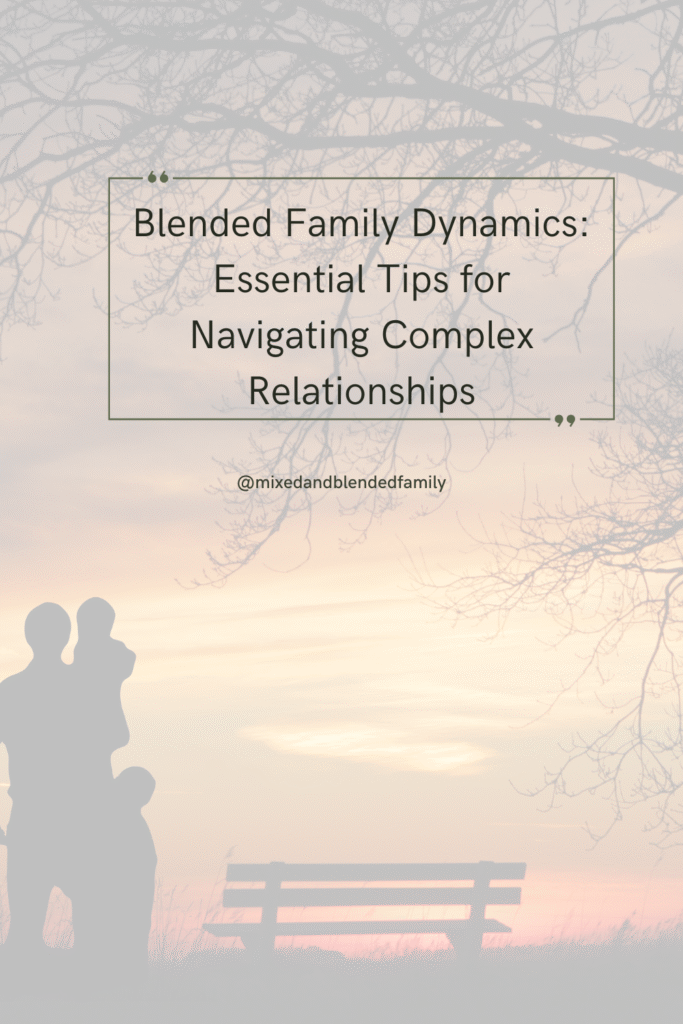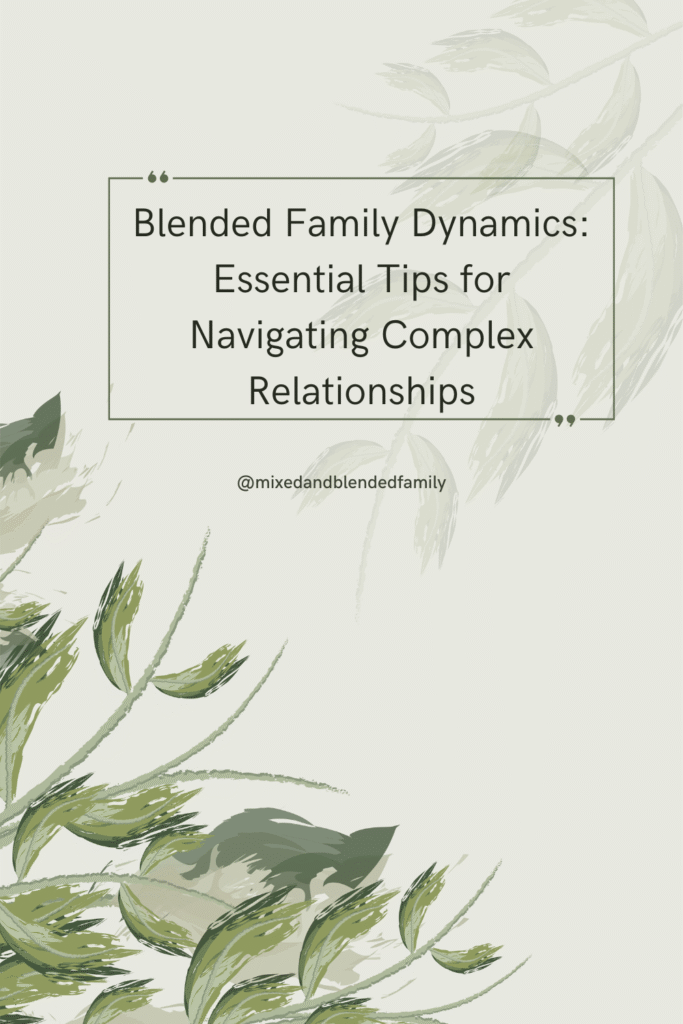
Blended Family Dynamics: Essential Tips for Navigating Complex Relationships
Blended family dynamics are like learning to conduct an orchestra where every musician is playing from a different sheet of music. After fifteen years of marriage, raising seven biological children, and being a stepmother to two more, I’ve learned that successful blended families aren’t built on perfection – they’re built on patience, understanding, and a whole lot of grace.
If you’re navigating your own complex family relationships, whether you’re newly blended or years into the journey, I want to share the wisdom I’ve gathered from the trenches of real-life blended family dynamics.

The Reality Check: It’s More Complex Than the Movies
Hollywood makes blended families look like a heartwarming montage where everyone comes together over a family dinner and suddenly you’re one big happy family. The reality of blended family dynamics is far more nuanced and, honestly, much more challenging than any movie portrays.
When I became a stepmother to two children while building a family with my then-husband, I quickly learned that blending families isn’t like mixing ingredients in a recipe. It’s more like trying to merge two established ecosystems – each with their own rules, traditions, relationships, and emotional landscapes.
The children came with their own history, their own relationship with their biological parent, and their own feelings about this new family structure. I came with my own expectations, my own parenting style, and my own vision of what our family should look like. My husband was caught in the middle, trying to honor his relationship with his children while building something new with me.
Understanding the Unique Challenges of Blended Family Dynamics
Loyalty Conflicts
Children in blended families often feel caught between loving their biological parents and accepting their stepparents. This creates blended family dynamics where kids might feel like they’re betraying one parent by connecting with another. Understanding this internal struggle is crucial for stepparents.
Different Parenting Styles
When two families merge, you’re not just blending children – you’re blending parenting philosophies, discipline approaches, and family values. These differences can create tension in blended family dynamics if not addressed thoughtfully.
Established Relationships vs. New Ones
Biological parent-child relationships have years of history, inside jokes, and established patterns. Stepparent-stepchild relationships are starting from scratch, which can feel unfair and create imbalance in blended family dynamics.
Extended Family Complications
Grandparents, aunts, uncles, and family friends all have to navigate these new relationships too. Holiday planning becomes complex, and blended family dynamics extend far beyond the immediate household.
Financial Complexity
Child support, different financial responsibilities, and decisions about spending on “his kids” versus “her kids” versus “our kids” can create stress in blended family dynamics.
Blended Family Wisdom: What I Wish I’d Known Earlier
Wisdom #1: Love Doesn’t Happen on Command
The biggest myth about blended family dynamics is that love should happen automatically. “Just love them like your own,” people said. But love is a relationship that builds over time through shared experiences, trust, and connection.
I learned to focus on respect and kindness first. Love might follow, but it can’t be forced. Some of my most successful relationships with my stepchildren were built on mutual respect rather than trying to recreate a biological parent-child dynamic.
Wisdom #2: The Biological Parent is the Bridge
In healthy blended family dynamics, the biological parent plays a crucial role as the bridge between their children and their new partner. They can’t stay neutral – they need to actively support the development of new relationships while maintaining their existing ones.
My husband had to learn to support me as a stepparent without undermining his relationship with his children. This meant having conversations with them about respect, helping them understand my role, and not allowing me to be treated poorly in the name of “understanding their feelings.”
Wisdom #3: Discipline Requires Strategy
One of the most challenging aspects of blended family dynamics is discipline. I learned that jumping into disciplinary roles too quickly can create resentment and resistance. Instead, I focused on building relationships first and letting discipline evolve naturally as trust developed.
The biological parent should handle major discipline issues, especially in the early years. The stepparent can enforce house rules and expectations, but the emotional heavy lifting of serious discipline should remain with the biological parent until relationships are well-established.
Wisdom #4: Your Home, Your Rules
While being sensitive to blended family dynamics is important, it’s equally important to establish that your home has rules that everyone follows. This isn’t about controlling children from another household – it’s about creating a safe, respectful environment for everyone.
We established family rules that applied to all children in our home, regardless of their biological parentage. This created consistency and helped all the kids understand that we were building something together.
Wisdom #5: Patience is Your Superpower
Successful blended family dynamics require patience measured in years, not months. Building trust, establishing new traditions, and creating a sense of family identity takes time. There will be setbacks, there will be moments of doubt, and there will be times when you question whether it’s working.
I learned to celebrate small victories – a stepchild asking for my help with homework, being included in a conversation, or simply having a peaceful family dinner. These moments were building blocks for stronger relationships.
Practical Strategies for Navigating Blended Family Dynamics
Create New Traditions Together
Rather than trying to force children to adopt traditions from either previous family, create new ones that belong to your blended family. This helps everyone feel included and gives your family its own unique identity.
We started having “family meeting nights” where we’d discuss schedules, plan activities, and let everyone have a voice in family decisions. These became sacred time for our blended family dynamics.
Respect the Other Parent
Even when it’s difficult, showing respect for the children’s other biological parent helps create healthier blended family dynamics. Children need to feel that the adults in their lives can coexist peacefully.
This doesn’t mean being best friends with your partner’s ex, but it does mean not badmouthing them in front of the children and supporting the kids’ relationship with their other parent.
Communicate Openly and Age-Appropriately
Children need to understand what’s happening in their family structure. Age-appropriate conversations about blended family dynamics help kids process their feelings and understand their place in the new family.
We had regular check-ins with the kids about how they were feeling, what was working, and what wasn’t. These conversations weren’t always easy, but they were necessary.
Maintain Individual Relationships
Don’t force group activities if individual relationships aren’t solid. Sometimes the best approach to blended family dynamics is building one-on-one connections first.
I made sure to spend individual time with each child, doing activities they enjoyed. This helped us build our own relationships without the pressure of group dynamics.
Set Realistic Expectations
Perfect blended family dynamics don’t exist. There will be good days and bad days, periods of harmony and periods of tension. Setting realistic expectations helps everyone adjust to the reality of blended family life.
When Blended Family Dynamics Change Again
Life threw us another curveball when my marriage ended and our blended family dynamics had to shift once again. The children I’d been a stepmother to for fifteen years were suddenly in a different relationship with me. Some connections remained strong, others became more distant.
This taught me that blended family dynamics are fluid. They change as circumstances change, as children grow up, and as life happens. The relationships you build during blended family years can survive transitions, but they might look different.
Blended Family Wisdom for Different Stages
Early Stage (First 1-2 Years)
Focus on building individual relationships rather than forcing family unity. Establish house rules and basic respect, but don’t expect instant love or loyalty.
Middle Stage (2-5 Years)
This is when blended family dynamics often become more natural. Children are more comfortable, traditions are established, and relationships have developed. Don’t get discouraged if this takes longer than expected.
Mature Stage (5+ Years)
By this point, healthy blended family dynamics should feel more natural. Children may still have complex feelings, but the family should function as a unit with established patterns and relationships.
Red Flags in Blended Family Dynamics
Some warning signs that blended family dynamics need professional support:
- Persistent hostility or aggression between family members
- A biological parent who consistently undermines their partner
- Children who refuse to follow basic house rules or show respect
- Stepparents who try to replace the biological parent rather than finding their own role
- Ongoing conflict that affects the children’s emotional wellbeing
The Gifts of Blended Family Dynamics
Despite the challenges, blended family dynamics can create beautiful, resilient families. Children learn flexibility, adaptability, and that families can take many forms. They often develop strong problem-solving skills and emotional intelligence.
Adults in blended families learn patience, compromise, and the art of building relationships intentionally. You discover that love can be chosen and cultivated, not just felt instinctively.
Advice for Parents Navigating Blended Family Dynamics
For Biological Parents: Your children need your support in building relationships with your partner, but they also need to know their relationship with you is secure. Don’t force connections, but don’t allow disrespect either.
For Stepparents: You’re not trying to replace anyone – you’re adding to the child’s life. Focus on building your own unique relationship rather than competing with biological parents.
For All Blended Family Members: Give it time. Blended family dynamics are complex and take years to develop. Be patient with yourself, with your partner, and with the children as everyone adjusts.
Looking Forward
My experience with blended family dynamics taught me that families are built on love, respect, and commitment – not just biology. The children who called me stepmom for fifteen years are still part of my heart, even though our family structure has changed again.
Blended family dynamics don’t have to be perfect to be beautiful. They just have to be real, honest, and built on a foundation of caring for each other’s wellbeing.
If you’re in the middle of navigating your own complex family relationships, remember that every family’s journey is different. What works for one blended family might not work for another, and that’s okay. The key is finding what works for your unique situation.
Final Thoughts
Blended family dynamics are challenging, rewarding, complex, and ultimately worth the effort when approached with wisdom, patience, and realistic expectations. The families we create through intention and choice can be just as strong and loving as those we’re born into.
Your blended family doesn’t have to look like anyone else’s to be successful. It just has to work for the people in it.
Are you navigating blended family dynamics? What challenges are you facing, and what wisdom have you gained? Share your experiences in the comments below or reach out at collab@mixedandblendedfamily.com. Let’s support each other through the beautiful complexity of blended family life.



